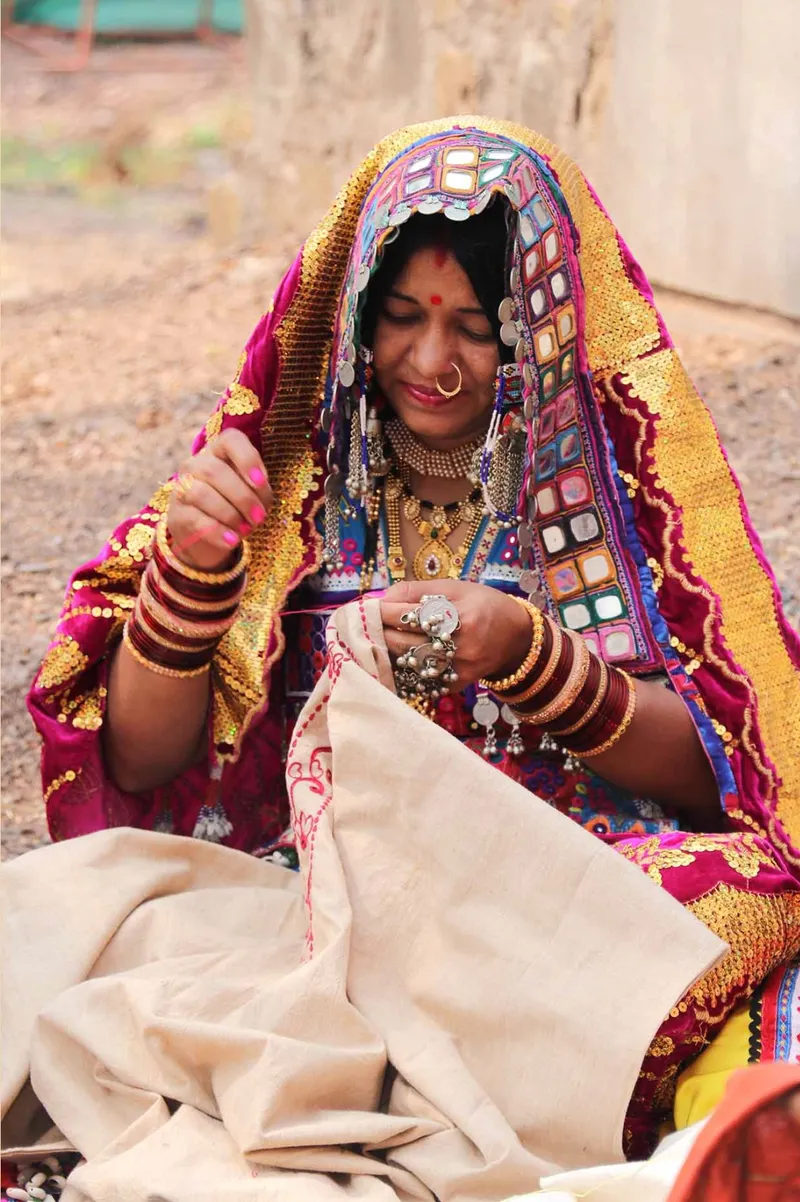Meet the social enterprise keeping the legacy of Lambani art alive
Founded by Asha Patil and Seema Kishore, Banjara Kasuti aims to give Lambani women a platform to practice their traditional craft while making a livelihood from it.
Komal Kesav Jadav is not just a breadwinner for her family—she is ensuring the survival of a centuries-old craft.
As the youngest generation of Lambani women in her family in the Arsikeri village of the Vijayapura district in Karnataka, Jadhav is part of a group helping preserve her community’s traditional textile handiwork.
Schooling was out of reach to her after Class 10, considering the nearest senior secondary school was more than 15 kilometres away.
While Jadhav grew up watching her mother, grandmother and aunts creating intricate embroidery and weaves, she—like many youngsters in the community—was dissuaded from pursuing it looking for brighter work prospects and living conditions.
Four years ago, when her parents made an intermittent income doing daily wage labour, she was introduced to Banjara Kasuti, a not-for-profit social enterprise founded by Asha Patil and Seema Kishore.
Banjara Kasuti helps proliferate the unique embroidery and mirror work of the Lambani communities by employing rural women from those communities and training them to incorporate their traditional handwork into modern-day fashion.
Today, Jadhav earns Rs 12,000-15,000 a month working with Banjara Kasuti and is able to support her family of four, including her younger brother’s education.
A centuries-old craft
The Lambanis, also known as the Banjaras or Lambadis, are a traditionally nomadic community from the Mewar region, now a part of modern-day Rajasthan. Today, they are largely settled across the southern parts of India, including Karnataka, Andhra Pradesh, and Telangana, with some presence in the northern regions as well.
Research shows that at a time when mechanised transportation systems were nonexistent, the transportation skills of the Lambadis were highly valued. Domesticated animals like cows and oxen, formed an important part of their economy as means of transport for themselves and goods for trade.
However, with the advent of British rule, the Lambadis were forced to abandon their traditional occupation of transporting goods due to the introduction of mechanised transport, the construction of roads, and the laying of rail lines by the colonial state.
This shift resulted in the loss of their traditional livelihood. After India gained independence, the Lambadis, along with other communities, were de-notified communities.
These communities were once 'notified', or categorised as being 'born criminals' during the British regime under a series of laws starting with the Criminal Tribes Act of 1871, leading to significant changes in their occupational structure.

Lambani embroidery uses a minimum of 14 types of stitches that are an amalgamation of patterns and shapes, making the garments intricate and festive.
For generations, Lambani women have been hand-stitching their own garments replete with vibrant fabrics, and intricate mirror and beadwork. Sandur Lambani Embroidery, a form of Lambani art, was recognised with a Geographical Indication (GI) tag in 2010.
However, being classified under the Scheduled Castes in Karnataka, the Lambadis’ increasing financial vulnerability was pushing the community’s women to abandon their traditional craftsmanship.
“The intricate craft of Lambani embroidery, with its colourful ghagra cholis adorned with up to 23 stitches, was slowly fading into obscurity. The harsh realities of seasonal migration coupled with the challenges of wearing heavy traditional attire in arduous work conditions further exacerbated the situation,” says Asha Patil, Founder of Banjara Kasuti.
Alarmed by the imminent loss of Lambani craftsmanship, homemaker and philanthropist Asha established Banjara Kasuti in 2017 along with her neighbour Seema Kishore.
“Our vision extended beyond mere preservation; we sought to empower Lambani women economically, instilling a sense of self-sufficiency and positioning them as independent entrepreneurs,” adds Asha, who grew up in Vijayapura around Lambani women and their fascinating clothing traditions.
After initial training to work on new-age garments, Banjara Kasuti’s women artisans pass on this knowledge to newer members.
Grassroots movement
The organisation sources organic handloom cotton from weavers in North Karnataka in an attempt to support sustainable livelihoods and uphold the traditional craftsmanship of local artisans.
Lambani embroidery uses a minimum of 14 types of stitches that are an amalgamation of patterns and shapes, making the garments intricate and festive.
All work is done by hand to preserve the cultural heritage of the art form while also countering the environmental impact of mass production techniques.
After several brainstorming sessions with inputs from local artisans and the Banjara community, Asha and Seema realised that organic cotton and khadi were the best-suited textiles for their needs. “These materials were sturdy enough to support the new-age designs without compromising their vibrancy and intricacy,” says Asha.
Banjara Kasuti relies on word-of-mouth within the community. Fellow community members play a crucial role in encouraging each other to join the organisation.
“This grassroots approach has proven effective in fostering trust and participation. The women gain access to a structured and regulated working environment that not only guarantees them a stable income but also helps them achieve financial independence,” Asha adds.
To date, close to 120 women of the Lambani community have benefitted from Banjara Kasuti with fixed monthly wages based on the quality of their skill set. These women also have access to banking services, education and healthcare.
Thirty-year-old Kavitha Rathore, who became associated with Banjara Kasuti years eight ago, says she is finally getting to continue the legacy of designing her own clothes that the women in her community did for generations.
“This has given me a chance to keep the practice alive while also earning a steady livelihood doing it,” says Rathore, who plans to fund education for her three children while also passing on their generational crafts.
“It’s getting the best of both worlds,” she says.
Edited by Jyoti Narayan






